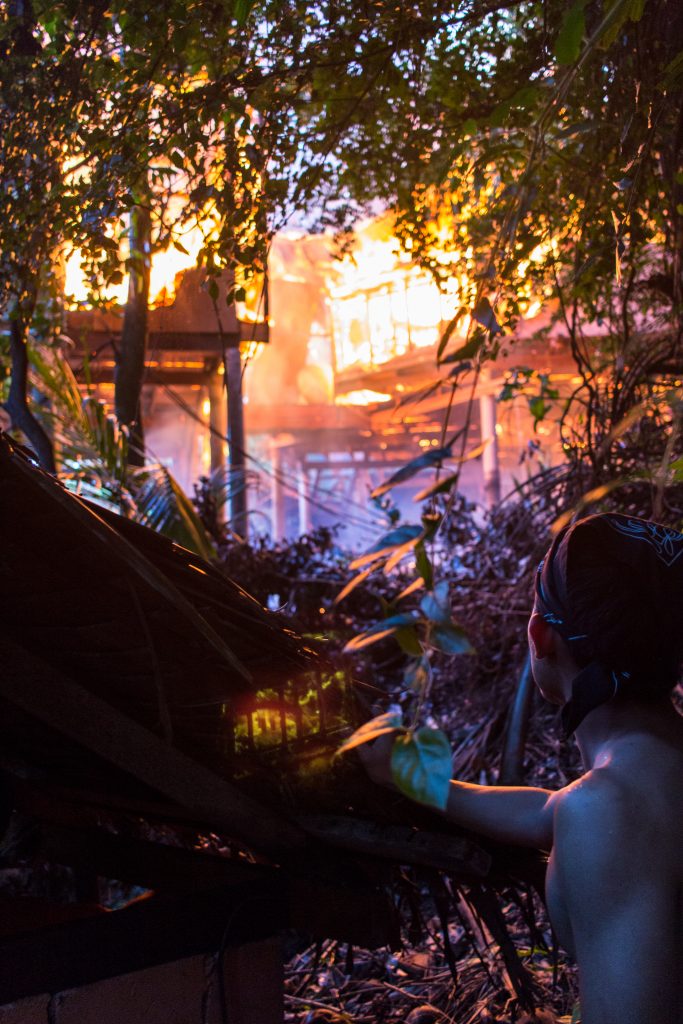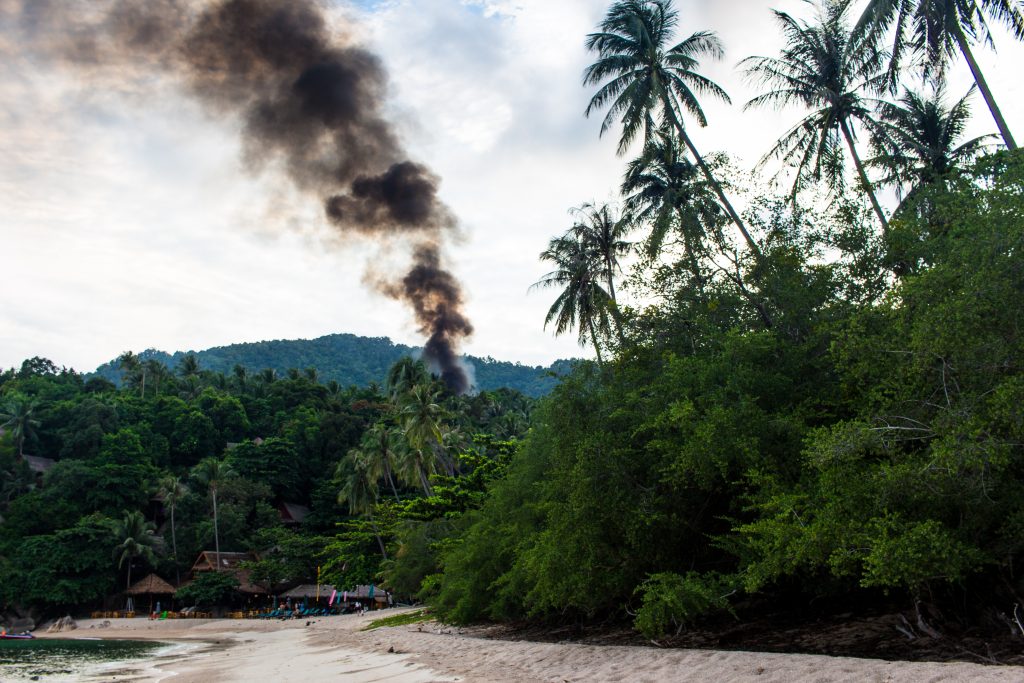
Photo of the Sanctuary fire by Stephen Shumaker
I have heard an argument against taking aggressive action to mitigate the effects of climate change, perhaps you’ve heard it too. Basically it goes like this: no matter what I do or Oregon does or the United States does, it will not make a significant difference in the global emissions, so why should I sacrifice now? I have always been a believer in the science of climate change. I have not always been a climate activist. We live in a paradoxical time; most people believe in the science, but do not act in a way that suggests a sense of urgency in halting the emissions of carbon into the atmosphere. Climate change is so fashionable that celebrities take private jets to climate summits!
There is something about having a child that refocused the issue for me. My daughter is now two. According to many estimates the most severe consequences, over a billion refugees, extreme global food and water shortages, are expected around 2050. For many people, myself included, it is difficult to think about 30 years in the future. I understand all too well the desire to employ some magical thinking that someone else will solve this thing. As we watch years pass, hurricanes and wildfires ravage communities, the arctic melts, and the Amazon burns. Forecasts only get more severe with each new report. I have to face the hard truth that it is not information or solutions that we lack, but the will to change. If this is the emergency that the scientific community is telling us that it is, why does the world still feel so normal? We know a fire is burning, but it is not yet at our door. It will be my daughter, as a 32 year old woman, navigating this dystopian reality unless we do something and fast. Scientists believe we have until 2030 to change course, but to do so requires us to change, all of us, in a monumental way. I can’t wait for some magical solution to arrive that does not require any sacrifice.
In thinking about this, I am often reminded of an experience I had a few years ago on a secluded beach in Thailand. To get to this remote beach one must take a ferry to the island of Koh Phagnan, then a ‘taxi’ which is really just a bench in the back of a pick-up truck crammed full of teenage backpackers going to the beach famous for its full moon party, from there one hires a private boat to take you around the cove to Haad Tien. This is a place known for its serenity. There are no cars or motorbikes because there are no roads. There is one wellness retreat known as ‘the Sanctuary’ which offers all manner of wellness treatments from yoga to craniosacral therapy. It is a place designed to promote maximum relaxation and healing. However, with a critical eye you can see that even this bastion of health and healing is not founded on sustainability. Even with plentiful sun, it is powered by dirty generators, a lot of drinking water comes in single-use plastic, and their waste management involves the majority of their trash burning in open pits. We got used to ignoring that generator hum in the distance as we went from lounging on the beach to eating delicious food, and passing by blissed out people with amazing posture everywhere we went. It was on a typically beautiful evening, we were taking photos for a friend on the beach, and waiting for a cacao ceremony to begin when I heard an explosion and then saw smoke rising from the top of the hill on which the community was built.

Photo by Stephen Shumaker
As we looked around, mostly we just saw what we always saw: blissed out people eating, swimming, lounging in hammocks, talking, laughing. In the distance, however, I could see some of the Thai employees running around in a way that made me think something serious was afoot. We went to the reception desk and asked what had happened and if we could help. They told us that everything was under control. Our friend decided to continue on to the cacao ceremony. My partner and I decided to investigate further.
The construction of this resort is anything but fire resistant. All of the bungalows are built out of bamboo with thatch roofs made from palm fronds. There is no fire department to call. There is not even much water pressure at the top of the hill because it is all gravity based. What we discovered is that one of the generators had exploded, the home of the owner of the resort was in flames, and it was being fought with a single garden hose that wasn’t long enough to reach the fire, and with hardly any water pressure at all. My partner decided to mobilize an old-fashioned bucket brigade. I decided to find all the fire extinguishers and get them to the top of the hill. They used the water to wet all the nearby bungalows. As we worked for hours, running up and down the hill, we found many people willing to help as soon as they were told that help was needed, and others who continued to walk along slowly and deliberately to or from their massages or ayurvedic treatments as we raced passed them. We were lucky that it was a windless night. The fire burned the owner’s house to the ground but did not spread; had the wind not been in our favor, the whole retreat may have burned down.
Why do I think about this in reference to climate change? There are a few reasons, one is this – if you look at any one action in isolation, it seems pointless. Will throwing this bucket of water put out the fire? The answer will almost certainly be no, and yet it is through collective action and organizing in the face of emergency that big things are possible. I also think about that instinct from the Sanctuary staff to tell us that everything is fine, continue about your leisurely activities, continue to spend your money, everything is fine. If we had waited for them to tell us there was an emergency, it would have been far too late to help. We are in that moment with climate change. It is an emergency. It is time to mobilize the bucket brigade. But the authorities are telling us that everything will be fine, keep spending money, keep driving, keep eating that beef. Part of the problem is that as more people act as if everything is normal, the harder it is to see and recognize the emergency for what it is.
I am aware that in telling this story there is a glaring hypocrisy. I flew to Thailand on a giant jet plane spewing tons of carbon into the atmosphere to have this experience (about the equivalent of driving an SUV 6000 miles). I would bet that most of the other new-age, wellness-oriented people on that beach believed in climate change and yet also got there by flying on planes. This is the disconnect that I have been struggling with since having my daughter. It is easy to point the finger at the “TimberUnity” folks. What is harder is to point the finger inward and ask myself if I am doing everything I can to protect my daughter from the future that awaits her if we do not change course. In 30 years it will be cold comfort in my daughter’s empty belly for her to realize there were worse people. As people who know the harm we are causing, we need to hold ourselves to a higher standard. I am trying to make choices and changes that reflect that we are in an emergency while there is still a chance, however small, that we might be able to save our kids the misery that our unsustainable society has wrought on them. It is a process still in progress, refining what in my life I can modify or give up, how I can speak up or advocate for change on a larger scale. I would ask anyone reading this to ask yourself a similar question. Are you signaling to other people the seriousness of the situation we are in? Are you doing everything you can to put out the fire?
Leave a Reply